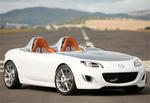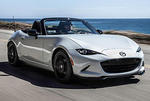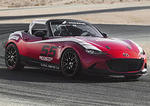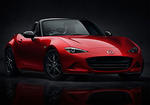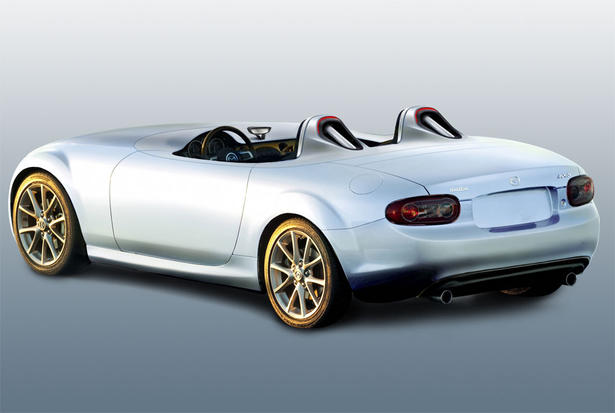
Mazda has officially unveiled today the Mazda MX5 Superlight at the Frankfurt Auto Show. The Mazda MX5 Superlight celebrates 20 years since the first MX5 roadster hit the streets. Under the hood of the Mazda MX5 Superlight there's a MZR 1.8-litre four-cylinder engine, coupled with a five-speed manual gearbox, that outputs 93 kW/126 PS at 6,500 rpm and 167 Nm of torque at 4,500 rpm. The Mazda MX5 Superlight is equipped with a cold-air intake, a special exhaust system, four-piston, fixed calliper brakes, a Bilstein B16 coil-over suspension and Eibach stabilizers.
The Mazda MX5 Superlight is able to reach 100 km/h from stand still in 8.9 seconds.
With the Mazda MX5 Superlight, the developers wanted to show how light a car can be, with the concept weighing just 995 kg. The Mazda MX5 Superlight has no roof or windshield, but it has an aluminum bonnet and various carbon fiber body parts.
Mazda Press Release:
This year Mazda celebrates the 20th anniversary of the first MX5 roadster, which laid the cornerstone for its Zoom-Zoom brand philosophy - reason enough for Mazda designers to create a fully-drivable show car, the Mazda MX5 Superlight version. There are no plans to build this car, but it demonstrates how individual mobility can be maintained in a way that uses fewer natural resources.
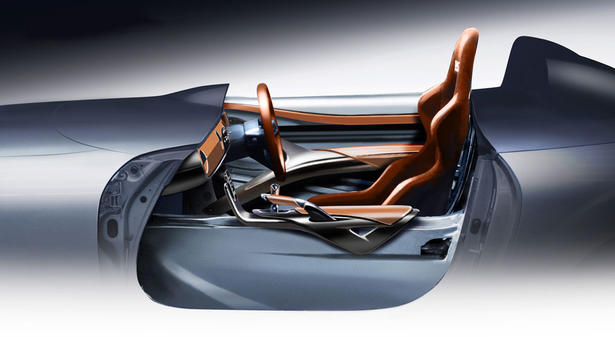

Mazda’s European R+D center in Oberursel has created a show car that represents the essence of Mazda’s fun-to-drive aspect. Based on the brand icon Mazda MX5 Roadster, the Mazda MX5 Superlight version is a pure, uncompromising two-seat sports car meant to be affordable to just about anyone. The main challenge for the design team in creating this roadster was “to evolve the MX5, developed to perfection during the last 20 years, to a higher and extreme level,” says Project Lead Designer Hasip Girgin. The result of their efforts is a roadster show car with an exciting design that is especially lightweight and distilled down to the very basics of sporty
driving, that still manages to provide modern safety technologies. In an increasingly digitalized world, it creates a linear, direct bond between man and machine. Its conceptual purity means even better driving dynamics and fuel efficiency, which is accomplished by keeping the vehicle below the 1000 kg threshold. As a show car for lightweight construction and driving enjoyment, the Mazda MX5 Superlight version is the ideal ambassador for Mazda’s brand values.
Exterior Design
“I’ve dreamed of building a Mazda MX5 with this kind of radical form for a long time,” says Peter Birtwhistle, Mazda Motor Europe’s Chief Designer, referring to the project. “Now that weight reduction has become a dominant factor in automotive development, the time is ripe for it. We show how lightweight a car today can be.”
His design team reduced the MX5 down to its core attributes to create a pure roadster. Development of the production model MX5 focussed on the bond between driver and co-pilot to the roadster, the car’s driving dynamics and its open-top experience. The goal of the Mazda MX5 Superlight version concept was to strengthen these bonds even further. By doing this without a windshield, the retractable top and its frame,
designers achieved an important step in this direction. As the concept Mazda MX5 Superlight version, the allweather production roadster has mutated into a driving machine that lets sports car enthusiasts enjoy the natural surroundings unfiltered and tangible. Not only does the wind blow unimpeded during driving, pilot and co-pilot can also experience the sounds, smells and temperature changes of their immediate surroundings. And finally, the show car’s intense bond between the driver and the technology of the vehicle gives it a unique closeness that can only be found in stronger form in the cockpit of a race car.
Mazda designers created special roll-over bars, not only because they are very sporty-looking, but also to contribute to aerodynamic efficiency. These also make it clear that roll-over protection is important in this concept. And they prevent wind turbulence around the heads of the passengers, from whom the law would require the wearing of helmets while driving.
By removing equipment not vital to driving, and by replacing vital things with components that support
the unique concept of the vehicle, designers sharpened the character of the Mazda MX5 Superlight version.
Because there is no windshield, for instance, there is obviously no need for wipers. The roadster show
car’s completely open design makes the need for outer door handles, side windows and their openers
unnecessary. A single, filigree aluminium, wide-angle mirror gives a good view of the road behind. It’s
placed inside an extension of the bonnet. Front and rear lights are the same as those of the production
model with additional LED lamps at the front, and brake lights at the back of each roll-over bar, which
contribute to the roadster’s sporty look.
The lack of a windshield required an extension of the original aluminium bonnet into the cabin. The
attached sheet here is made of lightweight carbon fibre and provides a hood for the dashboard frame.
This also changed the proportions of the body’s design, making the front of the car longer and the
passengers seem like they are sitting further back towards the rear-drive axle, all of which is enhanced
by the massive roll-over bars and their aerodynamic cladding. The Mazda MX5 Superlight version translates the
dramatic proportions of historical race cars into a very modern form.
Interior Design
The purity in design of the exterior also characterizes the interior design, which does not have aesthetics
as ultimate goal, but was conceived to contribute to reducing vehicle weight. Driver and passenger of the
Mazda MX5 Superlight version are greeted by racing bucket seats made of ultra-lightweight carbon fibre. They
are slide adjustable and upholstered with the same saddle coloured leather as the armrests, the steering
wheel, and the lightweight aluminium shift lever and hand brake. Colour-coordinated four-point seatbelts
hold the driver and passenger firmly in their seats.
The bonnet extension into the passenger cell provides a canopy for the dashboard, which makes the
dashboard look smaller than the production MX5. Made of lightweight plastic reinforced with fibreglass,
it contains the same instruments as the production MX5. These are held in place by a dashboard frame
made of lightweight carbon fibre. Like a purebred race car, the Mazda MX5 Superlight version has an ignition
button in the centre of the dashboard, along with two emergency kill buttons for immediate fuel and
electricity cut-off.
Supplying air and climate control to the open passenger compartment is only possible in limited form, so
the show car has no air conditioning and no fans. Air-flow is increased when the roadster accelerates, and
only small air vents are needed. The interior is made without any trim. Sound insulation mats and rugs do
not meet the requirements of a purist roadster like this and are not used at all.
Also made of ultra-lightweight carbon fibre is the “floating-design” centre console with iPod adaptor
and the triangular reinforcements in the trimless doors. Driver and passenger can rest their arms here
while driving.
Driving Dynamics
The Mazda MX5 Superlight version show car is fully-drivable, but there are no plans to produce it in
the near future. Under the bonnet is the cultivated and frugal MZR 1.8-litre four-cylinder engine paired
to the production roadster’s five-speed manual transmission. It develops 93 kW/126 PS of maximum
power at 6,500 rpm. For an appealing engine sound, there’s a Mazdaspeed cold-air intake made of
polished and powder-coated aluminium and a Mazdaspeed exhaust system, both of them specific to the
Mazda MX5 Superlight version. These systems deliver more intake air-flow, and less exhaust-gas back pressure.
The engine sound is designed to suggest an engine with much higher displacement than the concept
actually has. During charge cycles, a high-resonance bubbling sound in the muffler delivers the exciting
sporty sound you expect from a very powerful engine.
The show car is designed to provide improved driving dynamics as well, and uses a four-piston, fixedcalliper
brake system with perforated discs that, because of their size required an increase in track of
50 mm. A specially tuned chassis with a Bilstein B16 coil-over suspension and Eibach stabilisers give
the body of the Mazda MX5 Superlight version a ground clearance that is 30 mm lower than the production
MX5. Its sporty hydraulic power-assisted rack and pinion steering system is the same as that of the
regular roadster. Its linear steering, coupled to a precise-shifting five-speed manual transmission with
short shift travel, have contributed to the character of the world’s most successful roadster for years.
Also from the production model are the roadster’s 205/45 R17 original-equipment tyres and alloy wheels
from the 2.0-litre version, which are some of the lightest on the market today at less than 8 kg.
Building the Show Car
The task sounded challenging and time was short. After the decision was made to present a radical
Mazda MX5 Superlight version show car at the IAA in 2009, Peter Birtwhistle had only three
months to complete it. He quickly formed a five-person team – including Hasip Girgin, Luca Zollino,
Nigel Ratcliffe, Maria Greger und Luciana Silvares – which began by designing the cockpit.
There was not enough time for small-scale modelling. The designers put their ideas to paper, decided
which were best, then modelled these directly onto a full-scale clay model. The cockpit was created
together with the interior door braces. All components were then digitalized. This data was sent to an
external studio for prototype build, where the parts of fibreglass-reinforced plastic and carbon fibre
were made and later fitted. This method was also used to create the centre console with gear shift
lever and hand brake.
Parallel to this, a production MX5 Roadster
with an MZR 1.8-litre powertrain was stripped
of all components that would later be replaced.
Under the leadership of Mazda’s design team
and chassis engineers, a drivable “blank” of
the Mazda MX5 Superlight version was created that
weighed well under 1,000 kg, while respecting
the original roadster’s ideal 50/50 weight
distribution. Mazda test drivers then drove the
roadster around a closed track with experts from
Bilstein and Eibach, in order to ascertain the
feasibility of the project.
The results amazed even the most experienced engineers: with hardly any re-working, the
“light” MX5 version was an easy-to-control, safe-driving roadster that displayed agility, great driving
dynamics and acoustical appeal.
Final assembly began with painting the body in white colour, and simply polishing the original MX5
aluminium bonnet. Then the racing seats, steering wheel, gear shift lever and hand brake were
upholstered in leather and installed in the show car. This was followed by the installation of all
previously-built carbon fibre components. And at the end, Mazda designers installed the centre console,
the dashboard and instruments, seatbelts and roll-over bars.





